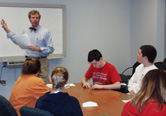 Last month, 10 ninth-graders from LaVista Junior High School’s High Ability Learner program attended a seminar on genetics at UNMC’s Munroe-Meyer Institute. It was the second consecutive year Maurice Godfrey, Ph.D., associate professor of pediatrics at the Center for Human Molecular Genetics, held the workshop for LaVista scholars.
Last month, 10 ninth-graders from LaVista Junior High School’s High Ability Learner program attended a seminar on genetics at UNMC’s Munroe-Meyer Institute. It was the second consecutive year Maurice Godfrey, Ph.D., associate professor of pediatrics at the Center for Human Molecular Genetics, held the workshop for LaVista scholars.
Dr. Godfrey kicked off the workshop by giving the students a “taste” of genetics — literally. He put them through an experiment to better understand how the ability to taste is a combination of the mouth and nose. Humans taste with the tongue, but what people call flavor is determined more by the sense of smell. The students learned about the five different types of taste receptors and tasted various foods with their nose open, then closed. The students quickly saw why food is less flavorful when an individual has a cold, or doesn’t smell as well.
The group then learned about connective tissue diseases and practiced separating chromosomes and segregating genes. They made Rebob animals from miniature marshmallows, thumbtacks and pipe cleaners. A Rebob animal is an educational tool designed by a geneticist in Wisconsin as a teaching tool for young students. Sitting at a conference table, the students worked with colored coded plastic strips and did exercises in reconfiguring genetic codes. Dr. Godfrey’s aim was to show them how groups of genes make up a human characteristic or trait.
 The seminar’s focus was in making basic science interesting and fun. The students particularly enjoyed a trip to Wittson Hall laboratories where they received a lesson on electro- microscopy by Tom Barger, electromicroscopy technologist in the department of cell biology and anatomy. Barger first showed the group a mouse embryo in a petri dish and then under the electron microscope. After barely seeing anything with the naked eye, the students were amazed at the vivid detail under the microscope.
The seminar’s focus was in making basic science interesting and fun. The students particularly enjoyed a trip to Wittson Hall laboratories where they received a lesson on electro- microscopy by Tom Barger, electromicroscopy technologist in the department of cell biology and anatomy. Barger first showed the group a mouse embryo in a petri dish and then under the electron microscope. After barely seeing anything with the naked eye, the students were amazed at the vivid detail under the microscope.
“Working with young students isn’t work for me,” Dr. Godfrey said. “To watch them grow in understanding and see them get excited is an instant gratification. In the lab, you have to undergo many experiments before you get to one of those exciting moments of revelation. It’s a joy to share these kids’ enthusiasm as they comprehend the science. A couple of them have already inquired if it’s possible to spend the summer working with me in the lab.”
Photo cutlines in descending order: Dr. Godfrey discusses gene mapping. Tom Barger explains the electron microscope to JoLynne Obrecht, left, Shay-Marie Kayne and Kevin Stormberg.